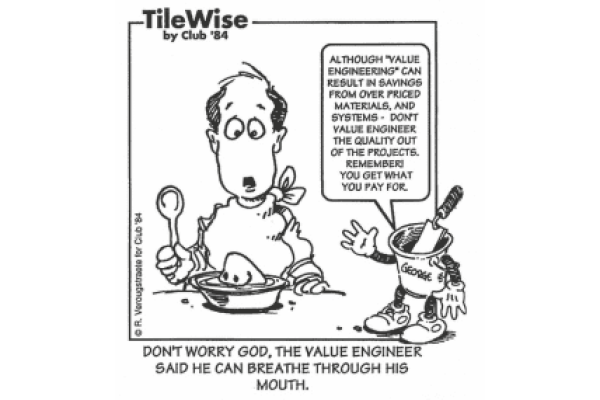Guest Blog Post By: University of Ceramic Tile and Stone (UofCTS)
At Coverings this year, one of the most important things that you will learn during the live session of the course, How to Get Tile and Stone Specifications Working with Architects, is Tracking and Protecting the Specification! #Coverings2024 #UofCTS
You can sign up now for the UofCTS live course at Coverings in April.
Understanding Value Engineering (VE)
- Value engineering can occur when the owner, GC and subcontractor singularly or jointly try to substitute products after the specification and/or contracts have been finalized. In theory, value engineering is substituting products with equal or better performance and quality, but at a lower cost. The savings might all go to the owner, or more often the subcontractor and the GC also profit from it. Although, typically value engineering ends up substituting specified products with lower quality products at a lower price. It is important that you track your specification to avoid value engineering for the wrong reasons. Understanding the value engineering process and being involved in the process to qualify it, will be essential to protecting your specification.
- “Value Engineering” means that specified products can be substituted with equal or better performing products at a lower cost. The savings might be necessary due to budgetary constraints. Often, it is misused where lower priced products, with less quality, are selected to increase profits.
Remember these Key elements when protecting your specification:
The Owner Has the Final Say!
- The owner of a project, whether a commercial or residential project, makes the final decisions. If the owner is convinced your product is the right product, then no one can change your specification. Don’t take this relationship for granted.
The Tile/Stone Subcontractor Has Discretionary Choice!
- In the tile and stone industry, the tile subcontractor/installer has a tremendous amount of discretionary choice. Most of the time, if your specification isn’t adequately protected, the tile installer can easily substitute lower priced products to increase their profits. In competitive bidding, the installers have to price their work as low as possible, and then hope if they get the job they can use alternates to increase their profits. The installers can say that their substitution is of equal quality, or better, even when it is not. The architect normally isn’t knowledgeable enough to determine otherwise.
- It is important that the tile subcontractor perceives you as being needed and part of his team. If the tile subcontractor needs you, they will want to give you the order and keep you involved in the process. If the tile contractor wants to switch products to make more money, they might perceive you as a threat and keep you at a distance. It is best to let them know that, if they feel like they have to try to switch out the specified product, then please give you the first chance to come up with an alternate.
The General Contractor Has Influence!
- The general contractor (GC) is the orchestrator of the project, and the contractor who ultimately is responsible if the subcontractors don’t perform their work correctly as they are hired by the owner. So, the GC has an incentive to hire good quality tile installers, but they are also greatly influenced by saving money and tend to want to go with the low bid. In theory, the rule is that the GC picks the best qualified low bid to perform the respective work. So, they need to vet the bids to make sure the tile installer is qualified to perform the installation, and that the tile contractor didn’t make any mistakes in their bid causing it to be unrealistically low.
The Architect and/or Designer Have Important Roles in the Process!
- An architect is strictly defined as a person who designs buildings, and in many cases, also supervises their construction. Architects are also described as a person who is responsible for inventing or realizing a particular idea or project.
- Architects and Designers are not just involved in the design of a building. As licensed professionals they can also be responsible for a certain amount of oversight on projects. Their role is important in every stage of the building’s construction, from the initial concept to the completion. They are motivated to maintain the specification as much as possible to see their initial vision come to life.
To get more details and dive deeper into this topic, learn more at the live session presented by UofCTS at Coverings 2024 on Monday, April 22 from 1:00 – 5:00 pm.
See you there! #Coverings2024 #UofCTS







